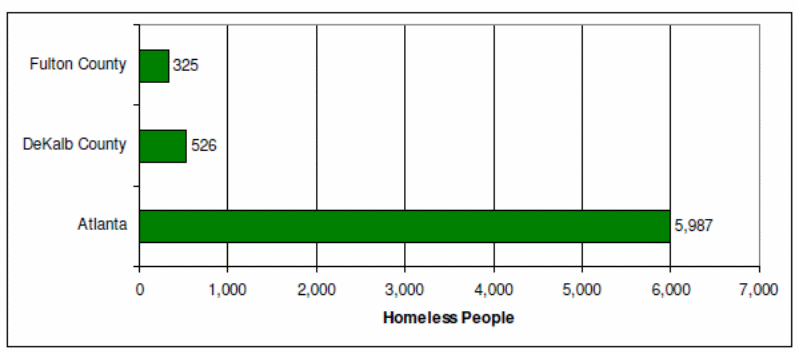The purpose of this fact sheet is to enhance understanding of the homeless population group from the national, state, and local perspective as a whole and factors that influence their health and wellness. The state of focus is Georgia and the County of Fulton.
Homelessness Nationally (2010, a given night of January)
- About 407,966 people were homeless in 2010. The state of homelessness refers being unsheltered, in transitional housing programs, or on streets (SAMHSA, 2011).
- Chronically homeless individuals were 109,812 (this represents a decrease of one percent from the previous year)
- In a year, more than 1,593,150 people experienced homelessness
Table 1: 2009-2010 Homelessness. Source: (SAMHSA, 2011)
Homelessness: Mental Illness and Substance Use, 2010
- About 26.2 percent of homeless individuals had severe cases of mental illnesses
- Nearly 34.7 percent homeless persons had cases of chronic substance use problems

Source: Web.
Factors that influence homelessness individuals’ health and wellness
- Poverty. Most households do not earn enough wages. Economic challenges have forced many people to homelessness.
- Experience of Violence. People who escape from domestic problems are likely to be homeless because of the circumstances and urgent needs for shelters. Some of the homeless individuals have the history of sexual and physical abuses. They also experience trauma from being homeless.
- Mental health and drug use. Homelessness causes emotional problems for affected individuals. Homeless individuals also experience high rates of behavioral challenges, especially children who exhibit severe hostility and aggression. They also have high rates of withdrawals, depression, anxiety, and worry. Homeless persons also exhibited high-levels of alcohol and drug use compared to other housed individuals. In addition, they show extreme cases of mood disorder, behavior challenges, post-traumatic stress disorder, and suicide attempts. Risks of mental problems are high among homeless individuals in comparison to housed individuals.
- Physical health. Most homeless individuals experience high rates of sickness more than housed persons do. For instance, they have high numbers of respiratory problems, infectious diseases, and gastrointestinal issues. This group also experiences nutritional deficiencies, overweight, and obesity because of unhealthy and poor diet. Homeless people have chaotic and difficult lives. These also include substance and alcohol abuse. As a result, provisions of healthcare services among the homeless groups have remained fragmented. They also have challenges in maintaining healthcare providers’ instruction and medication.
Homeless individuals have shown tendencies or unwillingness to engage with the healthcare service providers due to lack of money and trust. This is a barrier to effective provision of healthcare among the vulnerable homeless group. Homeless individuals also have barriers related to lack of healthcare insurance. Chronically homeless individuals and low-income adults do not have the Medicaid program. Various bodies in charge of coordination healthcare services for the homeless also lack unity. There are also cases of negative response and prejudice to homeless persons. Homelessness and prevailing conditions remain hazardous to healthcare provisions. This is because experiences of the homeless individuals result into new medical problems and exacerbate existing medical issues.
References
Pathways. (2011). The 2011 MetroO Atlanta Tri-Jurisdictional Collaborative Continuum of Care Homelessness Census. Web.
SAMHSA. (2011). Current Statistics on the Prevalence and Characteristics of People Experiencing Homelessness in the United States. Web.